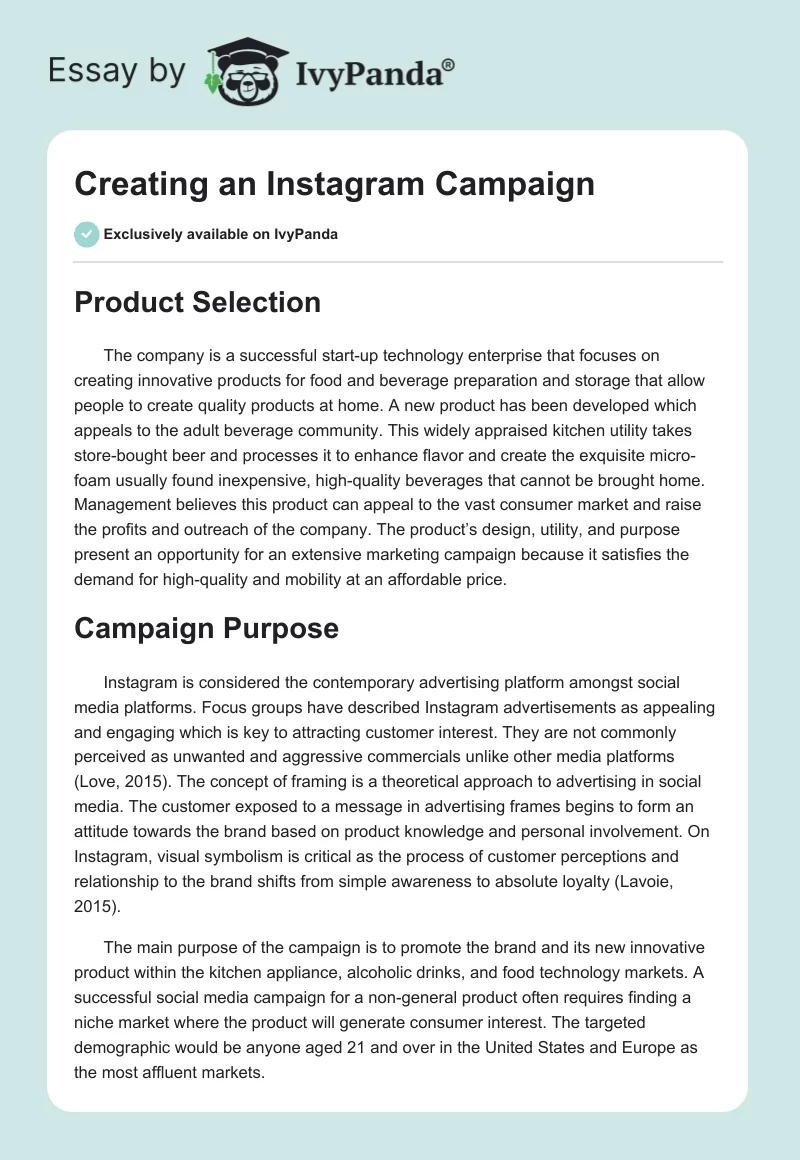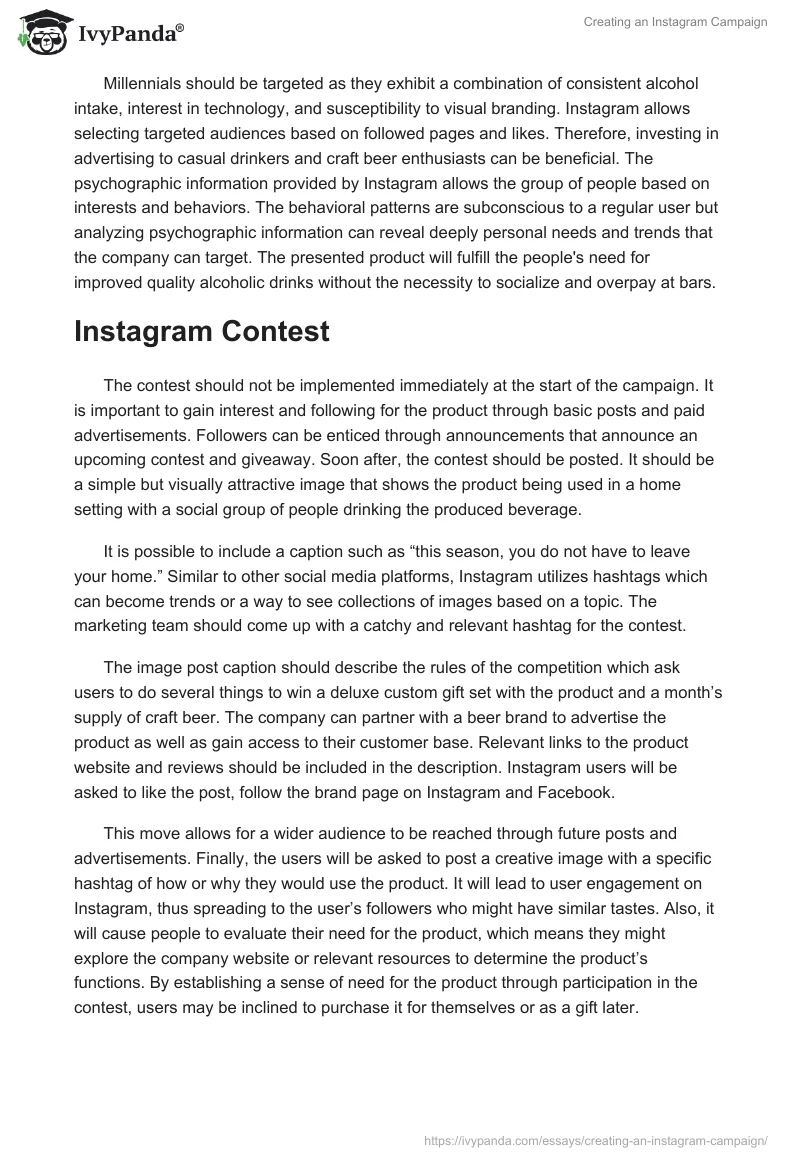Product Selection
The company is a successful start-up technology enterprise that focuses on creating innovative products for food and beverage preparation and storage that allow people to create quality products at home. A new product has been developed which appeals to the adult beverage community. This widely appraised kitchen utility takes store-bought beer and processes it to enhance flavor and create the exquisite micro-foam usually found inexpensive, high-quality beverages that cannot be brought home. Management believes this product can appeal to the vast consumer market and raise the profits and outreach of the company. The product’s design, utility, and purpose present an opportunity for an extensive marketing campaign because it satisfies the demand for high-quality and mobility at an affordable price.
Campaign Purpose
Instagram is considered the contemporary advertising platform amongst social media platforms. Focus groups have described Instagram advertisements as appealing and engaging which is key to attracting customer interest. They are not commonly perceived as unwanted and aggressive commercials unlike other media platforms (Love, 2015). The concept of framing is a theoretical approach to advertising in social media. The customer exposed to a message in advertising frames begins to form an attitude towards the brand based on product knowledge and personal involvement. On Instagram, visual symbolism is critical as the process of customer perceptions and relationship to the brand shifts from simple awareness to absolute loyalty (Lavoie, 2015).
The main purpose of the campaign is to promote the brand and its new innovative product within the kitchen appliance, alcoholic drinks, and food technology markets. A successful social media campaign for a non-general product often requires finding a niche market where the product will generate consumer interest. The targeted demographic would be anyone aged 21 and over in the United States and Europe as the most affluent markets.
Millennials should be targeted as they exhibit a combination of consistent alcohol intake, interest in technology, and susceptibility to visual branding. Instagram allows selecting targeted audiences based on followed pages and likes. Therefore, investing in advertising to casual drinkers and craft beer enthusiasts can be beneficial. The psychographic information provided by Instagram allows the group of people based on interests and behaviors. The behavioral patterns are subconscious to a regular user but analyzing psychographic information can reveal deeply personal needs and trends that the company can target. The presented product will fulfill the people’s need for improved quality alcoholic drinks without the necessity to socialize and overpay at bars.
Instagram Contest
The contest should not be implemented immediately at the start of the campaign. It is important to gain interest and following for the product through basic posts and paid advertisements. Followers can be enticed through announcements that announce an upcoming contest and giveaway. Soon after, the contest should be posted. It should be a simple but visually attractive image that shows the product being used in a home setting with a social group of people drinking the produced beverage.
It is possible to include a caption such as “this season, you do not have to leave your home.” Similar to other social media platforms, Instagram utilizes hashtags which can become trends or a way to see collections of images based on a topic. The marketing team should come up with a catchy and relevant hashtag for the contest.
The image post caption should describe the rules of the competition which ask users to do several things to win a deluxe custom gift set with the product and a month’s supply of craft beer. The company can partner with a beer brand to advertise the product as well as gain access to their customer base. Relevant links to the product website and reviews should be included in the description. Instagram users will be asked to like the post, follow the brand page on Instagram and Facebook.
This move allows for a wider audience to be reached through future posts and advertisements. Finally, the users will be asked to post a creative image with a specific hashtag of how or why they would use the product. It will lead to user engagement on Instagram, thus spreading to the user’s followers who might have similar tastes. Also, it will cause people to evaluate their need for the product, which means they might explore the company website or relevant resources to determine the product’s functions. By establishing a sense of need for the product through participation in the contest, users may be inclined to purchase it for themselves or as a gift later.
Campaign Metrics
Instagram has tools and 3rd-party software that help to measure the success of advertisement campaigns. The most relevant to this campaign would be to gauge the number of followers gained from the campaign as it is part of the contest. There is a metric that allows measuring user engagement by analyzing the number of likes and comments on a post. It is possible to analyze the hashtag performance which highlights the engagement and the discovery rate. Finally, the metric analyzing referral traffic from Instagram to the product website is crucial for tracking the return on investment of social media advertising (Instagram, 2017).
Campaign Benefits
The modern Instagram audience is based on the visual culture which follows the psychological process of instantaneous glances as the person swipes quickly through the images. Only something unusual and sensational will catch the consumer’s attention for more than a brief second. If consumers are drawn to an Instagram page or brand, it is likely they will follow it to see more images. Successful marketing campaigns focus on the brand-building aspect of Instagram so that more people are exposed to the company and its products. In turn, this results in rising sales, revenues, and word-of-mouth advertising. User participation allows creating a carefully crafted culture around the brand which is appealing for attracting new customers that will loyally buy the product (Carah & Shaul, 2016).
Visually demonstrating the product and its functions helps to build the customers’ trust. It appeals to their subconscious which is heavily influenced by the demand for satisfying desires. A futuristic design of the utility producing an enhanced version of a popular beverage serves as a trigger for the customer to participate in the contest, potentially buy the product, and follow the brand.
Active Versus Passive Marketing
There are various frameworks for advertising techniques that a company must consider when conducting a marketing campaign. Passive marketing consists of placing an advertisement or mention in any general media. Further, consumers may notice it and act on it if it is relevant to their needs. There is no targeted market or customer engagement as any general consumer will be exposed to the advertisement. Meanwhile, active marketing includes using interactive, platforms (such as Instagram) to target the consumers as well as engage in consistent advertisement and user interaction. It focuses on building popularity and provide continuous updates to those interested in the company or product (Joel, 2013).
The company can use passive marketing by creating a well-designed website page for the product and using necessary technology resources to appear in search engines when relevant keywords are entered. It is possible to place an advertisement with Google that will determine to show it to potential customers based on its user interest algorithms. This type of passive marketing requires little input after initial development while reaching potential customers through anticipatory tactics that provide up-to-date information.
References
Carah, N., & Shaul, M. (2016). Brands and Instagram: Point, tap, swipe, glance. Mobile Media and Communication, 4(1), 69-84. Web.
Joel, M. (2013). Two terms marketers need for today’s media landscape. Web.
Instagram. (2017). Build your business on Instagram. Web.
Lavoie, K. (2015). Instagram and branding: A case study of Dunkin’ Donuts. Elon Journal of Undergraduate Research in Communications, 6(2), 79-90. Web.
Love, K. (2015). Social media and the evolution of social advertising through Facebook, Twitter and Instagram. Web.


